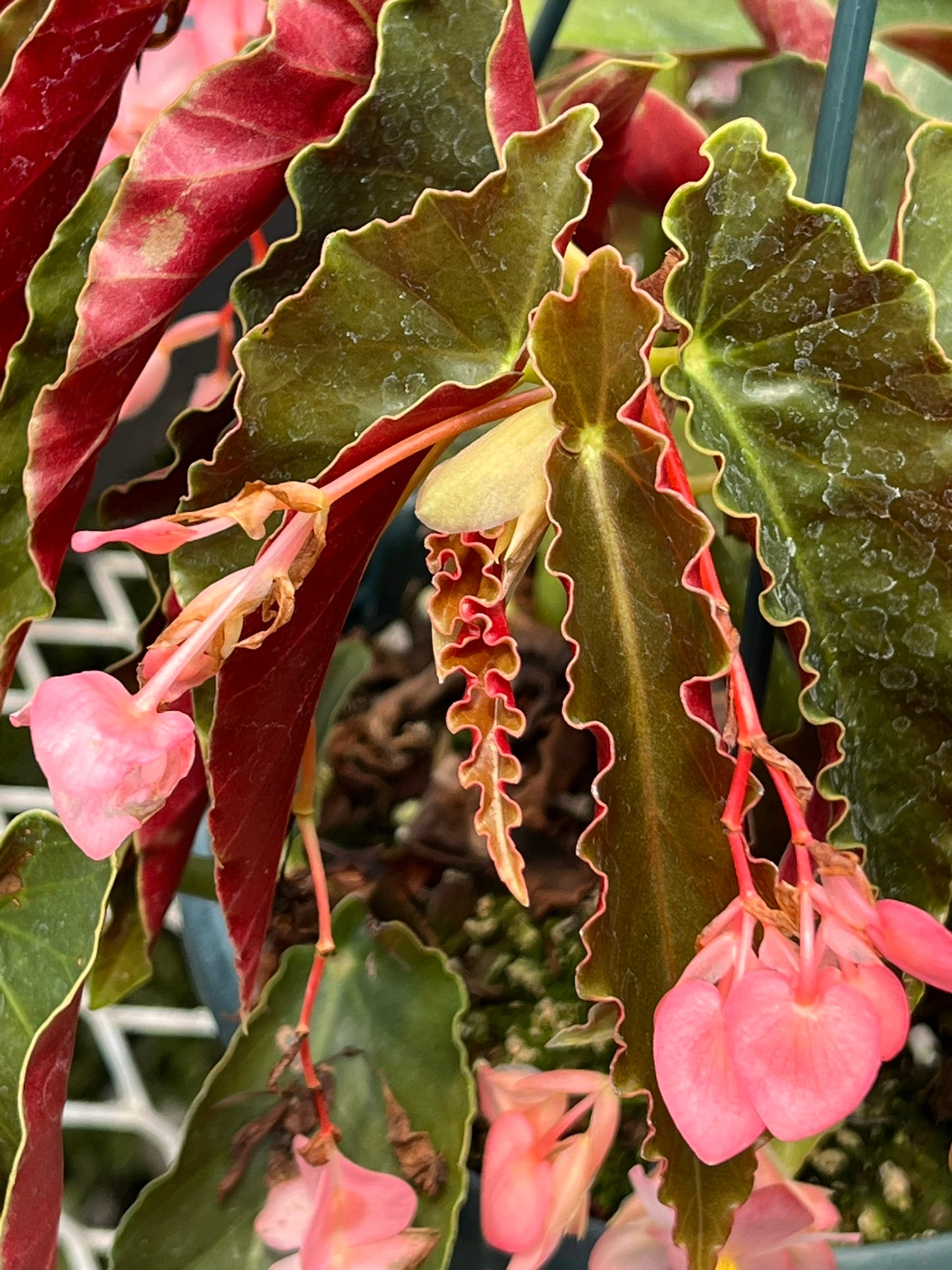Plant Hoarder
Begonia Jim's Cotton Candy
Begonia Jim's Cotton Candy
Couldn't load pickup availability
Share
Hardiness Zone:9
Sun Exposure:Part Sun, Mostly Shade and Shade
Begonia ‘Jim’s Cotton Candy’: A Sweet and Stunning Splash of Color
Whimsical Leaves, Playful Personality, and Surprisingly Easy Care
If you’re searching for a begonia that feels like pure joy—light, fun, and full of color—then Begonia ‘Jim’s Cotton Candy’ is your dream plant. Just like the spun-sugar treat it’s named for, this plant brings a sense of delight to any space it touches. With bright pinks, soft silvers, and playful leaf textures, it's a true conversation starter that’s as charming as it is beautiful.
But don’t let its vibrant, candy-colored appearance fool you—this begonia is easy to grow, especially once you understand its simple needs. It’s well-suited for indoor displays, patio containers, or even a shady spot in your garden.
Let’s explore why ‘Jim’s Cotton Candy’ is such a delight—and how to help it thrive in your care.
What Makes ‘Jim’s Cotton Candy’ So Special?
This variety is part of the rex begonia group, known for dazzling foliage. And it’s easy to see why this one turns heads!
-
Candy-Colored Leaves: Big, broad leaves swirled with pink, blush, silver, and pale green. The edges may have subtle ripples or darker borders, giving it extra flair.
-
Compact Growth: Grows low and full, making it ideal for pots, desktops, or small shade gardens.
-
Eye-Catching Texture: Leaves have a soft, velvety surface and bold veining that creates dramatic contrast.
-
Playful Vibe: There’s nothing serious or stiff about this plant. It’s joyful and full of personality.
It’s a true showpiece—even when it’s not in bloom.
How to Grow Begonia ‘Jim’s Cotton Candy’
You don’t need to be a seasoned gardener to enjoy this plant. Follow these simple steps to keep it happy and healthy.
1. Light Requirements
‘Jim’s Cotton Candy’ prefers bright, indirect light. It loves light—but not the kind that scorches. Too much direct sun can fade or burn those delicate colors.
-
Indoors: Place near an east or north-facing window. Avoid hot windows with intense afternoon sun.
-
Outdoors: Choose a spot with dappled shade or filtered light, like under a tree or porch roof.
If your plant starts to stretch or lose its color, it may need more light.
2. Soil Mix
Good drainage is key. This begonia likes moisture but hates soggy roots. Use a light, airy potting mix that drains fast and holds just enough water.
Recommended mix:
-
2 parts peat moss or coco coir
-
1 part perlite or vermiculite
-
1 part compost or orchid bark
Always plant in a container with drainage holes. That’s non-negotiable!
3. Watering
Water when the top inch of soil feels dry. You want the roots to stay lightly moist, not waterlogged.
-
Water at the base to avoid spotting the leaves
-
Let the excess water drain fully—never let the pot sit in water
-
In winter, reduce watering as growth slows down
Pro Tip: Use room-temperature water. Cold water can shock the roots and affect leaf color.
4. Humidity and Temperature
Begonia ‘Jim’s Cotton Candy’ loves humidity—just like other rex begonias. Aim for 50% or higher, especially indoors where air can get dry.
To boost humidity:
-
Place a tray of water and pebbles under the pot
-
Use a small room humidifier nearby
-
Group it with other humidity-loving plants
Keep temperatures between 65–75°F (18–24°C). Avoid drafts, cold air, and sudden temperature swings.
Fertilizing for Best Results
Feed lightly but regularly during the growing season (spring to early fall).
-
Use a balanced, water-soluble fertilizer like 10-10-10
-
Apply every 3–4 weeks, diluted to half strength
-
Don’t fertilize in winter when growth slows
Overfeeding can lead to leaf burn or dull colors, so always err on the side of caution.
Pruning and Grooming
‘Jim’s Cotton Candy’ stays fairly compact, but a bit of grooming keeps it looking fresh.
-
Remove yellow or damaged leaves regularly
-
Pinch off leggy stems to encourage bushier growth
-
Wipe leaves gently to remove dust and bring out their shine
You can also propagate new plants by rooting healthy leaf or stem cuttings in moist soil or water. Sharing this beauty is half the fun!
Growing It Indoors vs. Outdoors
This plant shines in both settings—but your care routine may differ slightly.
Indoors:
-
Place near a bright window with filtered light
-
Watch humidity and water with care
-
Rotate every few weeks to keep growth even
Outdoors (Zones 9–11 or summer):
-
Grow in a pot or shaded garden bed
-
Protect from rain and direct afternoon sun
-
Bring indoors before temperatures drop below 50°F
In cooler zones, enjoy it as a seasonal patio plant or year-round houseplant.
Overwintering Tips
If you’re bringing your plant indoors for winter:
-
Check for pests before moving it inside
-
Trim back any long or damaged growth
-
Place in bright, indirect light
-
Reduce watering—keep soil barely moist
-
Skip fertilizer until spring returns
The plant may go a bit quiet during winter, but it’ll bounce back with color and growth in the spring.
Common Problems (and Easy Fixes)
Even the sweetest plants can have a few hiccups. Here’s what to watch for:
-
Brown Leaf Edges? Dry air or inconsistent watering. Boost humidity and water more evenly.
-
Yellowing Leaves? Too much water or poor drainage. Let the soil dry out slightly between waterings.
-
Faded Colors? Not enough light. Move to a brighter location—just avoid direct sun.
-
Pests (mealybugs, mites)? Wipe with neem oil or use insecticidal soap weekly until resolved.
Why You’ll Love Begonia ‘Jim’s Cotton Candy’
There’s something incredibly joyful about this plant. Maybe it’s the playful colors. Maybe it’s the soft, fuzzy leaves. Or maybe it’s the way it brightens a shelf, a windowsill, or a shady garden corner like a scoop of pink sorbet on a hot day.
Here’s what makes it special:
-
Incredible color and texture, like nothing else in your collection
-
Compact and easy to care for, even in small spaces
-
Perfect for gifting or sharing, thanks to easy propagation
-
Thrives in pots, patios, or shade gardens, with minimal fuss
-
Brings a cheerful, happy vibe everywhere it grows
Begonia ‘Jim’s Cotton Candy’ isn’t just a plant—it’s a mood. It’s the sweet, whimsical touch your home or garden has been waiting for. And once you see those swirled, sugar-pink leaves in person?
You’ll be hooked.


